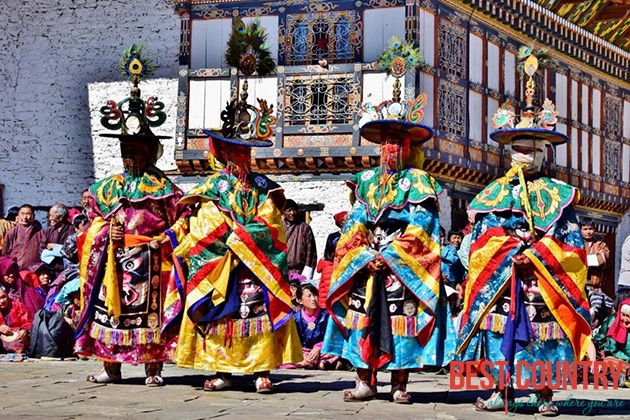Festivals and Holidays in Bhutan

The most renowned of these are the Tsechu (10th day) festivals, commemorating the deeds of Padmasambhava.
Locally referred to as 'Guru Rimpoche' or, simply as 'Guru,' this eighth century master, introduced the Nyingma school of Buddhism into Tibet and Bhutan.
Each 10th day of the lunar calendar is said to commemorate a special event in the life of Padmasambhava; and some of these are dramatized in the context of a religious festival. Most festival lasts from three to five days - one of which, usually, falls on the 10th day of the lunar calendar.
Of these festivals the Paro Tsechu, in the spring, and the Wangue and Thimpu Tsechus, in the fall, are the most impressive. These festivals are very popular with western tourists.
The festivals in Bumthang and East Bhutan attract fewer tourists and those who want to get a more authentic flavor of Bhutan's cultural and religious extravaganza will be well rewarded.
Paro Tsechu
All religious and lay people of Paro and neighborhood areas, dressed and adorned in their finest attend the festivals, with a belief that they will get their sins washed away and will accumulate merits.
This is also an occasion of social gatherings. There will be a series of mask dance performances mainly by monks with some folk singing and dancing as well.
Thimphu Tsechu
The Thimphu Tsechu (religious festival) is one of the biggest and most spectacular of the Buddhist festivals faithfully celebrated in Bhutan, Himalayan Kingdom of the Thunder Dragon.
Both monks and lay people perform in the dances and dramas as an act of meditation, seeking to personify the deity that they portray.
Masked and dressed in elaborate costumes of silk brocade, dancers demonstrate the triumph of good over evil and the power of compassion to the haunting sounds of trumpets, cymbals and flutes.
Today this beautiful and sacred festival remains a wonderful manifestation of a religious faith that is still a crucial part of Bhutanese daily life.
Jambay Lhakang Bumthang Drub
This festival held in the picturesque valley of Bumthang gained its popularity from the visits of tourist in the recent years.
In addition to the mask dances, Jambay Lhakhang Temple built in the year 659 host the "Mewang" (Fire blessing) and "Tercham" (Dance of Treasure).
It is believed that the Tercham can bless the infertile women with children, and is only performed during the night.